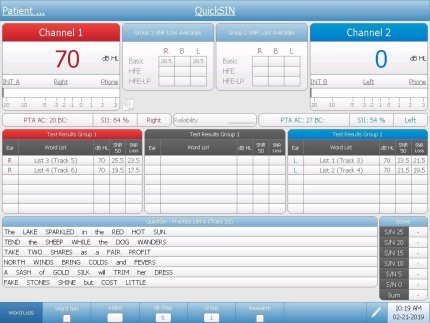Quick Speech-in-Noise (QuickSIN) Test
Audiometry Guides
Why is QuickSIN testing important?
Often, the primary complaint of hearing-impaired people is that they experience difficulty understanding others in background noise. Speech in Noise Audiometry testing is used to help diagnose this and understand the severity of hearing loss and the ability of the patient to hear in background noise. One of these tests is the Quick Speech in Noise Test (QuickSIN).

How does QuickSIN testing work?
With this test, the patient repeats sentences that are embedded in different noisy environments and the result is an SNR (signal-to-noise ratio) loss. The measurement of SNR loss is crucial, as speech understanding in noise cannot be reliably predicted from the pure tone audiogram.
Presentation Levels
QuickSIN audiometry testing should be performed following pure tone audiometry. When the pure-tone average (PTA) is less than or equal to 45 dB HL, present the test stimuli at 70 dB HL. When the PTA is 50 dB HL or greater, test stimuli should be presented at levels judged by the patient to be “loud, but okay.” The test stimuli are pre-recorded sentences embedded in speech babble at varying signal-to-noise ratios from easy to very difficult.
Test Instructions
“Imagine that you are at a party. There will be a woman talking and several other talkers in the background. The woman’s voice is easy to hear at first, because her voice is louder than the others. Repeat each sentence the woman says. The background talkers will gradually become louder, making it difficult to understand the woman’s voice, but please guess and repeat as much of each sentence as possible.”
Test Procedure with AudioStar Pro
1. Press the More button and select QuickSIN.
2. Verify the test ear, transducer, and presentation level in Channel 1.
3. Press the Channel 1 present bar to present the first sentence.
4. By default, the 5 key words will be scored as correct. Press the INCORRECT button for each word repeated incorrectly by the patient.
5. Select Word Nav and use the front panel navigation buttons or an external mouse to select the next sentence.
6. Continue presenting each sentence and scoring the patients incorrect responses until all 6 sentences in the list are completed. Press Store to save the test results.
7. The SNR Loss score will appear in the Test Results window.
8. Select additional lists for testing if necessary.
9. Repeat the test is the other ear.
Interpreting QuickSIN Test Results
To interpret the QuickSIN test results, refer to the following table.
|
SNR Loss
|
Degree of SNR Loss
|
Expected Improvement with
Directional Mic
|
|
0-3 dB
|
Normal/Near Normal
|
May hear better than those with normal hearing are able to in noise
|
|
3-7 dB
|
Mild SNR Loss
|
May hear almost as well as those with normal hearing are able to hear in noise
|
|
7-15 dB
|
Moderate SNR Loss
|
Directional microphones help; consider array mic
|
|
>15 dB
|
Severe SNR Loss
|
Maximum SNR improvement is needed; consider FM system
|